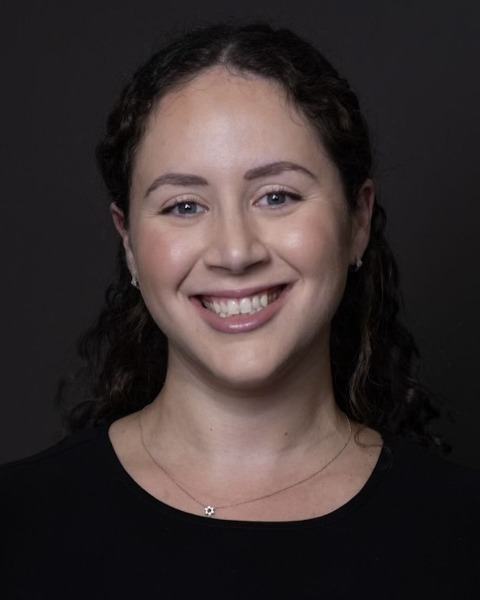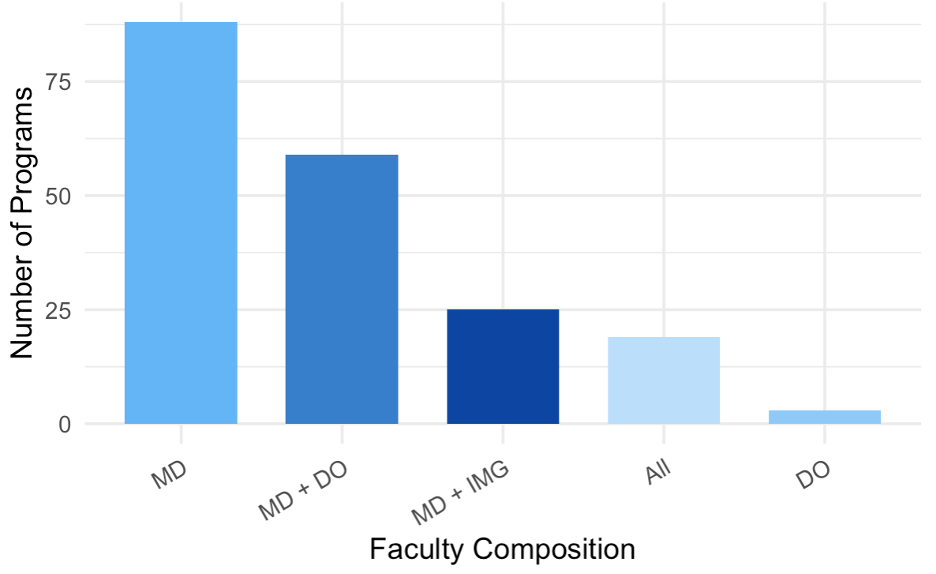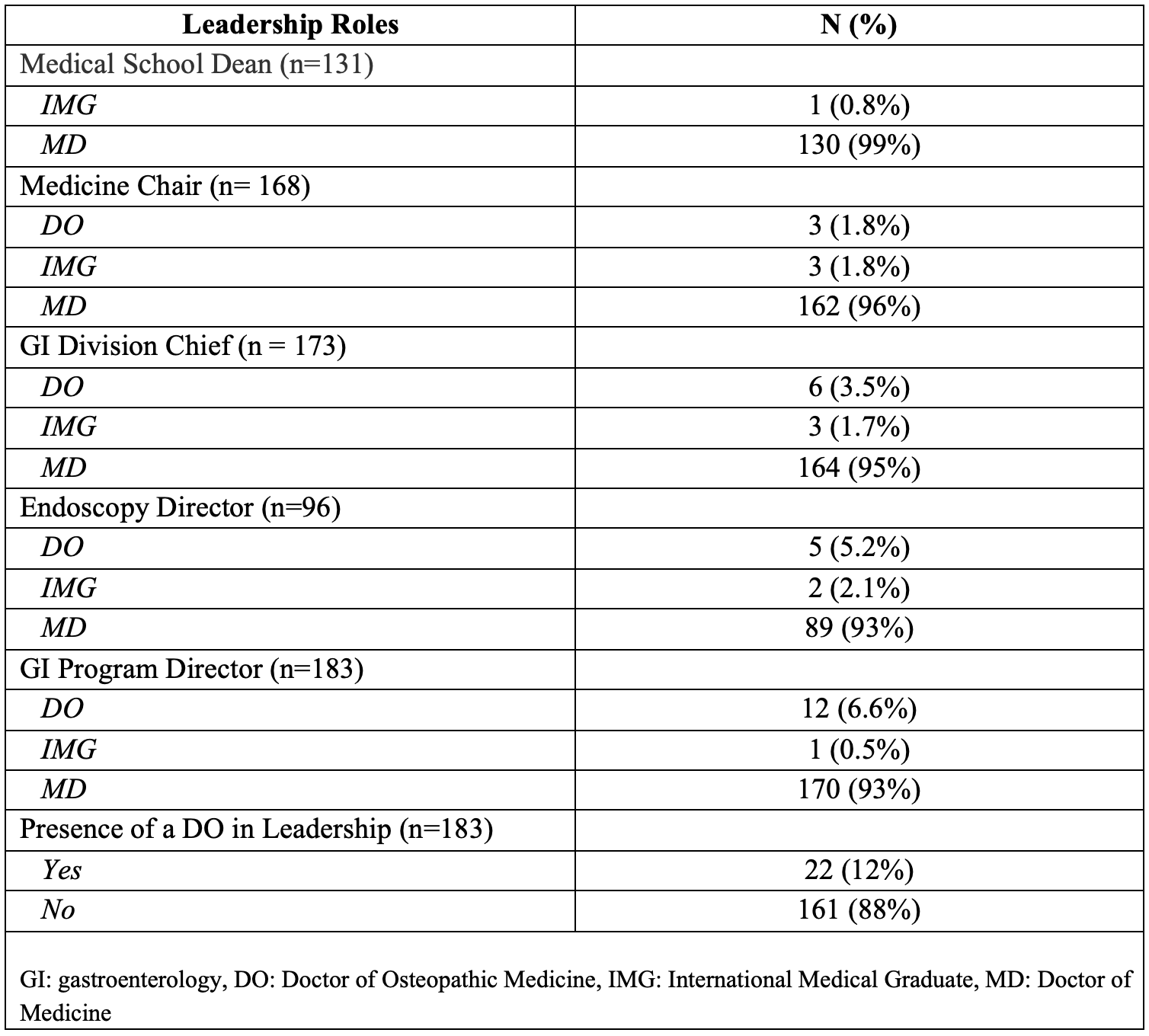Tuesday Poster Session
Category: Practice Management
P6192 - Underrepresentation of Osteopathic Medical Graduate Degrees Among Gastroenterology Faculty and Leadership in the United States
Tuesday, October 28, 2025
10:30 AM - 4:00 PM PDT
Location: Exhibit Hall

Marni H. Wilkoff, DO (she/her/hers)
Mount Sinai West, Icahn School of Medicine at Mount Sinai
New York, NY
Presenting Author(s)
Marni H. Wilkoff, DO1, Alexandria Markley, MD1, Rama Hussein, DO1, Nivita Sharma, MD2, Mako Koseki, MD1, Rashmi Advani, MD3, Yuying Luo, MD4, Loren Rabinowitz, MD5, Haley Zylberberg, MD, MS6
1Mount Sinai West, Icahn School of Medicine at Mount Sinai, New York, NY; 2University of California San Diego, San Diego, CA; 3Mount Sinai South Nassau,Icahn School of Medicine at Mount Sinai, Oceanside, NY; 4Mount Sinai West & Morningside, New York, NY; 5Beth Israel Deaconess Medical Center, Boston, MA; 6Weill Cornell Medicine, New York, NY
Introduction: Osteopathic physicians (DOs) and international medical graduates (IMGs) are underrepresented in gastroenterology (GI) when compared to Doctors of Medicine (MD), making up 6.6% and 29.7% of the workforce, respectively. The aim of this study was to evaluate the representation of DOs among GI faculty across the United States (US) and to assess factors associated with increased representation.
Methods: We conducted a cross-sectional study of all American College of Graduate Medical Education accredited GI fellowship programs in the US in 2023. Program characteristics were collected from websites and through direct contact. Among 224 programs, 194 had all faculty listed. We collected US region, institution type, number of faculty members, type of medical degree, and presence of a DO in leadership. We evaluated for presence of DO in univariate analyses using Wilcoxon signed-rank and chi-squared tests and a multivariable logistic regression model.
Results: Of 194 programs, there were 3,900 faculty members of which 93.6% had MDs, 0.9% had DOs, and 2.5% had IMGs (p< .001). Only 9.8% of programs had representation of all degree types (Figure 1). When evaluating faculty composition, MDs made up a higher median percentage of faculty compared to DOs (n=78 programs, 89.7% vs 7.7%, p< .001). Among 183 programs with leadership roles available (Table 1), DOs made up 12% of leadership positions. On univariate analyses, presence of a DO on faculty was associated with increased DOs among leadership positions (25% vs 2.8%, p< .001) and non-university-based programs (20% vs 7.1%, p=0.008), but not with region. These associations remained significant in a multivariable logistic regression model adjusted for region and faculty size (p< 0.01).
Discussion: Overall, DOs remain underrepresented among GI faculty. Given that DOs emphasize a holistic, patient-centered approach and usually have experience with community-based care, ensuring their inclusion on academic faculty can help enrich the field of GI. We found that the presence of a DO on faculty was linked to increased DOs in leadership. This suggests that representation at senior levels may foster greater inclusion and opportunity for DOs.

Figure: Figure 1. Distribution of Programs by Faculty Composition

Figure: Table 1. Distribution of Leadership Roles Per Program by Medical Degree Type
Disclosures:
Marni Wilkoff indicated no relevant financial relationships.
Alexandria Markley indicated no relevant financial relationships.
Rama Hussein indicated no relevant financial relationships.
Nivita Sharma indicated no relevant financial relationships.
Mako Koseki indicated no relevant financial relationships.
Rashmi Advani indicated no relevant financial relationships.
Yuying Luo: Ardelyx – Grant/Research Support.
Loren Rabinowitz indicated no relevant financial relationships.
Haley Zylberberg indicated no relevant financial relationships.
Marni H. Wilkoff, DO1, Alexandria Markley, MD1, Rama Hussein, DO1, Nivita Sharma, MD2, Mako Koseki, MD1, Rashmi Advani, MD3, Yuying Luo, MD4, Loren Rabinowitz, MD5, Haley Zylberberg, MD, MS6. P6192 - Underrepresentation of Osteopathic Medical Graduate Degrees Among Gastroenterology Faculty and Leadership in the United States, ACG 2025 Annual Scientific Meeting Abstracts. Phoenix, AZ: American College of Gastroenterology.
1Mount Sinai West, Icahn School of Medicine at Mount Sinai, New York, NY; 2University of California San Diego, San Diego, CA; 3Mount Sinai South Nassau,Icahn School of Medicine at Mount Sinai, Oceanside, NY; 4Mount Sinai West & Morningside, New York, NY; 5Beth Israel Deaconess Medical Center, Boston, MA; 6Weill Cornell Medicine, New York, NY
Introduction: Osteopathic physicians (DOs) and international medical graduates (IMGs) are underrepresented in gastroenterology (GI) when compared to Doctors of Medicine (MD), making up 6.6% and 29.7% of the workforce, respectively. The aim of this study was to evaluate the representation of DOs among GI faculty across the United States (US) and to assess factors associated with increased representation.
Methods: We conducted a cross-sectional study of all American College of Graduate Medical Education accredited GI fellowship programs in the US in 2023. Program characteristics were collected from websites and through direct contact. Among 224 programs, 194 had all faculty listed. We collected US region, institution type, number of faculty members, type of medical degree, and presence of a DO in leadership. We evaluated for presence of DO in univariate analyses using Wilcoxon signed-rank and chi-squared tests and a multivariable logistic regression model.
Results: Of 194 programs, there were 3,900 faculty members of which 93.6% had MDs, 0.9% had DOs, and 2.5% had IMGs (p< .001). Only 9.8% of programs had representation of all degree types (Figure 1). When evaluating faculty composition, MDs made up a higher median percentage of faculty compared to DOs (n=78 programs, 89.7% vs 7.7%, p< .001). Among 183 programs with leadership roles available (Table 1), DOs made up 12% of leadership positions. On univariate analyses, presence of a DO on faculty was associated with increased DOs among leadership positions (25% vs 2.8%, p< .001) and non-university-based programs (20% vs 7.1%, p=0.008), but not with region. These associations remained significant in a multivariable logistic regression model adjusted for region and faculty size (p< 0.01).
Discussion: Overall, DOs remain underrepresented among GI faculty. Given that DOs emphasize a holistic, patient-centered approach and usually have experience with community-based care, ensuring their inclusion on academic faculty can help enrich the field of GI. We found that the presence of a DO on faculty was linked to increased DOs in leadership. This suggests that representation at senior levels may foster greater inclusion and opportunity for DOs.

Figure: Figure 1. Distribution of Programs by Faculty Composition

Figure: Table 1. Distribution of Leadership Roles Per Program by Medical Degree Type
Disclosures:
Marni Wilkoff indicated no relevant financial relationships.
Alexandria Markley indicated no relevant financial relationships.
Rama Hussein indicated no relevant financial relationships.
Nivita Sharma indicated no relevant financial relationships.
Mako Koseki indicated no relevant financial relationships.
Rashmi Advani indicated no relevant financial relationships.
Yuying Luo: Ardelyx – Grant/Research Support.
Loren Rabinowitz indicated no relevant financial relationships.
Haley Zylberberg indicated no relevant financial relationships.
Marni H. Wilkoff, DO1, Alexandria Markley, MD1, Rama Hussein, DO1, Nivita Sharma, MD2, Mako Koseki, MD1, Rashmi Advani, MD3, Yuying Luo, MD4, Loren Rabinowitz, MD5, Haley Zylberberg, MD, MS6. P6192 - Underrepresentation of Osteopathic Medical Graduate Degrees Among Gastroenterology Faculty and Leadership in the United States, ACG 2025 Annual Scientific Meeting Abstracts. Phoenix, AZ: American College of Gastroenterology.

